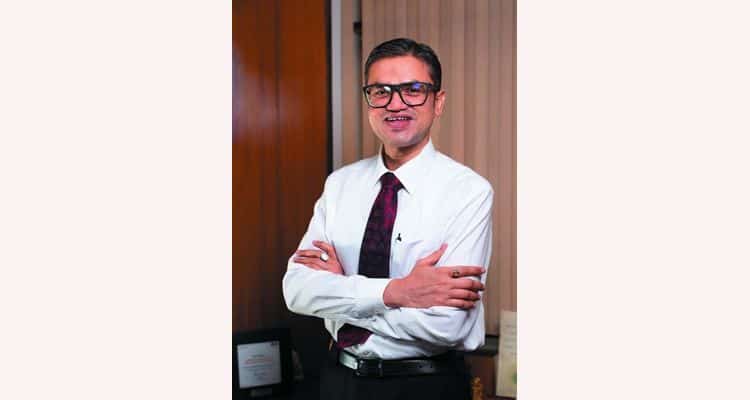Jatin Mahajan, MD, J Mitra & Company highlights tech trends in healthcare to watch out for
Technology has had a far-ranging impact on the healthcare industry in the past two decades. And this has received further impetus in the past 18 months driven by the complications of the corona pandemic. Artificial Intelligence (AI), Machine Learning (ML), Internet of Medical Things (IoMT), big data, and blockchain are aspects that have been driving these technological developments within healthcare, positively impacting the quality of life considerably. Other trends catalysing extraordinary results are Telemedicine, Virtual Reality (VR), Mobile Health, Cloud Computing, Nanotechnology, 3D Printing, and Predictive Analytics. So, what do all these trends translate into?
Technology has been impacting healthcare primarily on these critical fronts
- Making it more affordable and cost-effective
- Making it mobile and closing the gap between patient and diagnostic / treatment (from wearables to portable medical devices)
- Catalysing better quality of diagnostics/treatments (increased efficiency of all medical devices and introduction of newer techniques)
- At the forefront of precision medicine (robotics)
- Impacting quality of life and helping people live longer
All future trends are moving in these directions. Some of the critical trends for the next few years will be:
Wearables and smart devices-Several wearable devices now constantly monitor a patient’s vital parameters. These wearables include embedded (into patient’s bodies) medical devices such as pacemakers & cochlear implants; and those worn on the surface of a person’s body, including glasses, watches, sensors, and even clothing. These wearable devices enable healthcare workers to have real-time information on patient data while they remain at home.
Telehealth & telemedicine-Telehealth will further bridge the gap between rural and urban communities. One of the significant benefits of telehealth over in-person alternatives is that it reduces contact between patients, healthcare workers, and other patients. The corona pandemic has provided an impetus to the use of telehealth resources. Telehealth’s growth appears likely to continue even after the pandemic is over.
Virtual reality- It is already impacting healthcare in many ways: from training doctors to helping individuals overcome phobias. In addition, several potential uses for Virtual Reality could transform the way we view and treat chronic diseases. According to research published by Deloitte, there are three main usage areas for Virtual Reality in medicine: as a tool for diagnostics, treatment, and therapies, and as an educational resource. More specifically, Virtual Reality has already demonstrated significant benefits in making treatments more effective, reducing costs associated with patient care, providing better access to specialists, and accelerating the development of new drugs. In addition, Virtual Reality is an exciting trend in healthcare and is being used for training surgeons and providing therapy after traumatic events such as terrorist attacks or natural disasters in many countries.
Voice-controlled assistants-Technological advances enable medical professionals to leverage digital tools, including speech recognition systems. In healthcare settings, this may include components designed to optimize patient care or reduce clinician workloads. These tools can be used for clinical documentation and data management or as a voice assistant that streamlines daily workflows.
Robotic surgery-It is playing a very significant role in healthcare. It is a new technique for minimally invasive surgery where the surgeon uses a robotic device with attached instruments to perform surgical procedures. The robot requires no skin incision, which reduces blood loss and wound complications immensely. In countries like Canada, France, Germany, and Australia, Robotic Surgery is considered the standard treatment for prostate cancer – and the trend is fast pervading other organs and diseases.
Artificial Intelligence (AI)-It has transformed the healthcare space and become the absolute game-changers. AI can analyse and decode data in far complex and distinct combinations than a human mind, providing exceptionally potent data for efficient and precise diagnostics. Within AI applications, medical imaging has become the leading and most popular field. Other AI applications of intelligent and automated healthcare systems include image-guided therapy, tailor-made data-driven preventive medicine, closed-loop drug delivery, life-support systems, and robotic surgery.
With the help of AI, complex and chronic diseases like cardiovascular diseases, various types of cancer, diabetes, Alzheimer’s, echocardiography, neurology screening, in-vitro fertilization, and genomics interpretation can be analysed and effectively interpreted.
Internet of Medical Things (IoMT) and Machine Learning (ML)-IoT has disrupted the healthcare industry by intelligently connecting devices, systems, and objects used by billions of people worldwide to utilize and leverage data and enable more timely, specific, and contextualized decisions.
IOTs impact on the Healthcare segment is humongous. Across the world, the healthcare industry is transforming itself into a system that is well-coordinated, user-centric, and more efficient. IoT as an evolving technology is driving game-changing and life-enhancing solutions across the healthcare segment. IoT catalyses the automation of processes, and the advantages are endless.
In Conclusion
AI, IoT, and ML have changed the way medical services are delivered. The future of IoT is very bright in the healthcare segment, with an estimated 20 billion connected devices and growing exponentially day by day.
In healthcare, technology has grown exponentially over the years. We have moved from illness-focused patient care to a more holistic and unified preventive mindset driven by the diagnostics revolution based on technological trends. Technology has impacted the diagnostics industry in many ways. For example, physicians can diagnose a patient through their phone instead of being limited to only seeing them physically in person. Mobile Technology saves both time and cost for hospitals and doctors while also improving access for patients requiring immediate care, especially in rural and resource-scarce settings. With the increased use of technology, there are more ways to diagnose health problems than ever before. Doctors and medical professionals constantly upgrade their knowledge and adjust their practices to keep up with all these innovations that make diagnosis and treatment faster and easier.
Ultimately, the best way to predict the future is to create it by fostering innovation. The merger of medicine and engineering and the blurring of the distinction are the most significant trends driving technology in healthcare.
- Advertisement -


